Global Fit for D0-
D0 Mixing
(allowing for CP violation)
(through 21 December 2021)
People working on this:
Alan Schwartz,
Marco Gersabeck
For a complete list of references click
here
For world average values of measured observables (used below) click
here
Notation:
The mass eigenstates are denoted
D 1 ≡ p|D0> +
q|D0> and
D 2 ≡ p|D0> −
q|D0>;
δ and δKππ are strong phase differences
between
D0
→ f and D0 → f amplitudes, and
φ is the weak phase difference Arg(q/p). We define
δ ≡
δ D0 → K−n(π)
−
δ D0
→ K−n(π).
The mixing parameters are defined as
x ≡ (m2 − m1)/Γ and
y ≡ (Γ2 − Γ1)/(2Γ), where
Γ = (Γ1 + Γ2)/2.
Our convention is (CP)|D0> =
−|D0>
and
(CP)|D0> =
−|D0>; thus, in the absence of CP violation,
x = (mCP+ − mCP−)/Γ and
y = (ΓCP+ − ΓCP−)/(2Γ).
Experimental Observables:
From all experiments, there are 61 measurements of 16 observables:
y CP ,
A Γ ,
(x, y, |q/p|, φ) Belle
K0S π+ π − ,
(xCP, yCP, Δx, Δy) LHCb
K0S π+ π − ,
(x, y) BaBar
K0S h+ h− ,
(x, y) BaBar
π0 π+ π− ,
(R M )/2 LHCb
K+ π− π+ π − ,
(R M ) semileptonic ,
(x", y")
K+ π− π 0 ,
(R D , x2, y, cos δ, sin δ)
Ψ(3770) ,
(RD, AD, x'2±,
y'±)BaBar ,
(RD, AD, x'2±,
y'±)Belle ,
(RD, x'2, y')CDF ,
(RD±, x'2±, y'±)LHCb ,
(ACPK,
ACPπ)BaBar ,
(ACPK,
ACPπ)Belle ,
(ACPK −
ACPπ)CDF ,
(ACPK −ACPπ)
LHCb(D*) ,
(ACPK −ACPπ)
LHCb(B →D0μX)
Theoretical Parameters:
Allowing for CP violation, there are 10 fitted parameters:
x, y, δ, δKππ,
RD,
AD, Aπ, AK,
|q/p|, and Arg(q/p) = φ.
The first two parameters govern mixing; the next two are
strong phases; RD is the ratio
Γ(D0→
f)/Γ(D0 → f);
the next three are direct CP-violating asymmetries for
D0 → K+ π−,
D0 → π+ π−, and
D0 → K+ K−, respectively;
and the last two are indirect CP-violating parameters.
The phase φ corresponds to a basis in which the dominant
U-spin-changing (ΔU=2) dispersive and absorptive mixing
amplitudes are real; see
Kagan and Silvestrini, Eq. 107.
(Choosing a basis ensures that Arg(q/p) is physically meaningful.)
The relationships between these parameters and the measured
observables are given below. The observables appear in
blue
(on the left sides of the equations), the underlying parameters in
magenta
(on the right sides), and intermediate variables in black.
In addition, we perform a fit for alternative mixing and CP violation parameters as
described below: (x12, y12, φ12) for Fit #2, and
(x12, y12, φM2, φΓ2)
for Fit #3.
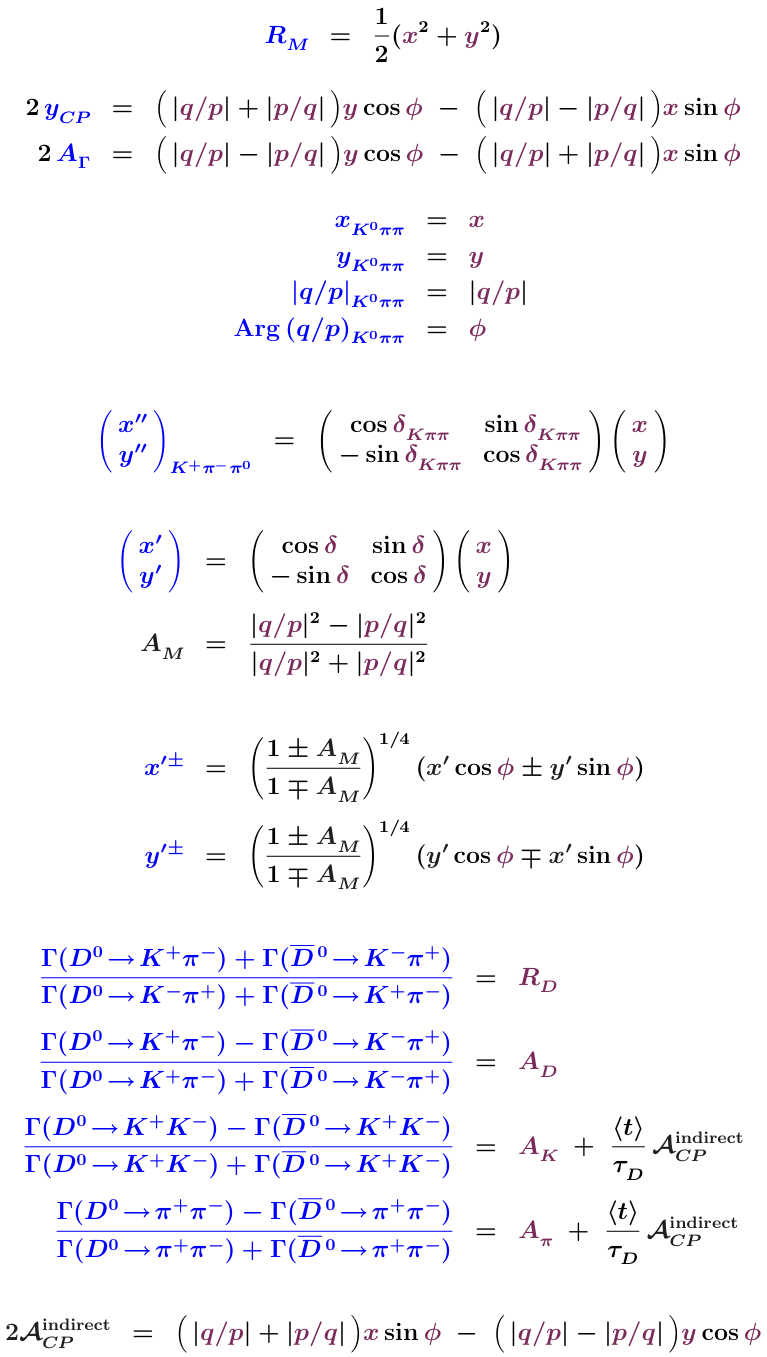
Measurements used:
| Index |
Observable |
Value |
Source |
| 1 |
y CP |
(0.719 ± 0.113)% |
World average (COMBOS combination)
of D0 → K+ K− /
π+ π − /
K+ K− K0
|
| 2 |
A Γ |
(0.0089 ± 0.0113)% |
World average (COMBOS combination)
of D0 → K+ K− /
π+ π − results
|
| |
| x (no CPV) |
| y (no CPV) |
| |
| |
| |q/p| (no dCPV) |
| Arg(q/p)=φ (no dCPV) |
| |
| |
| x |
| y |
| |q/p| |
| φ |
|
| |
| 0.56 ± 0.19 +0.067 −0.127
|
| 0.30 ± 0.15 +0.050 −0.078
|
| |
| 0.90 +0.16 −0.15
+0.078 −0.064
|
| (−6 ± 11 +4.2 −5 )
degrees |
| |
| (0.58 ± 0.19 +0.0734 −0.1177 )%
|
| (0.27 ± 0.16 +0.0546 −0.0854 )%
|
| 0.82 +0.20 −0.18
+0.0807 −0.0645
|
| (−13 +12 −13
+4.15 −4.77 ) degrees |
|
Belle D0 → K0 S
π+ π − results using
921 fb−1.
|
Correlation coefficient is +0.012 for no-CPV; for CPV-allowed they are:
|
| 1 | | 0.054 | |
−0.074 | | −0.031 |
| 0.054 | | 1 | |
0.034 | | −0.019 |
| −0.074 | | 0.034 |
|
1 | | 0.044 |
| −0.031 | | −0.019 | |
0.044 | | 1 |
|
| |
| x (no CPV) |
| y (no CPV) |
| |
| xCP |
| yCP |
| Δx |
| Δy |
| |
| xCP |
| yCP |
| Δx |
| Δy |
|
| (−0.86 ± 0.53 ± 0.17)% |
| (0.03 ± 0.46 ± 0.13)% |
| |
| (0.27 ± 0.16 ± 0.04)% |
| (0.74 ± 0.36 ± 0.11)% |
| (−0.053 ± 0.070 ± 0.022)% |
| (0.06 ± 0.16 ± 0.03)% |
| |
| (0.397 ± 0.046 ± 0.029)% |
| (0.459 ± 0.120 ± 0.085)% |
| (−0.027 ± 0.018 ± 0.001)% |
| (0.020 ± 0.036 ± 0.013)% |
|
|
LHCb
D0 →
K0S π+π −
results using 1 fb-1 (√s = 7 TeV) |
|
D*+ → D0π+ flavor tag.
Correlation coefficient = +0.37, no CPV. |
| |
|
3 fb-1 results (√s = 7, 8 TeV) allowing for CPV. |
|
D*+ → D0π+,
B → D0μ− X flavor tags.
Correlation coefficients (stat. + syst.): |
| 1 | | (−0.17 + 0.15) |
| (0.04 + 0.01) | |
(−0.02 − 0.02) |
| | | 1 |
| (−0.03 − 0.05) |
| (0.01 − 0.03) |
| | | | |
1 | | (−0.13 + 0.14) |
|
| |
|
5.4 fb-1 results (√s = 13 TeV) allowing for CPV. |
|
D*+ → D0π+ flavor tags.
Correlation coefficients (stat. + syst.): |
| 1 | | (0.11 + 0.13) |
| (−0.02 + 0.01) | |
(−0.01 + 0.01) |
| | | 1 |
| (−0.01 − 0.02) |
| (−0.05 + 0.01) |
| | | | |
1 | | (0.08 + 0.31) |
|
| For (x, y, |q/p|, φ) → (xCP, yCP, Δx, Δy)
mapping, see
PRD 99, 012007 (2019)
|
|
| 15-16 |
|
| (0.16 ± 0.23 ± 0.12 ± 0.08)% |
| (0.57 ± 0.20 ± 0.13 ± 0.07)% |
|
|
BaBar
D0 →
K0S π+π − and
D0 →
K0S K+ K − combined; |
|
Correlation coefficient = +0.0615, no CPV. |
|
| 17-18 |
|
| (1.5 ± 1.2 ± 0.6)% |
| (0.2 ± 0.9 ± 0.5)% |
|
|
BaBar
D0 →
π0 π+π − |
|
Correlation coefficient = −0.006, no CPV. |
|
| 19 |
(x2 + y2)/2 |
(0.0130 ± 0.0269)% |
World average (COMBOS combination)
of
D0 → K+l− ν results |
| 20-21 |
|
| (2.61 +0.57 −0.68 ± 0.39)% |
| (−0.06 +0.55 −0.64 ± 0.34)% |
|
|
BaBar
K+ π − π 0 result;
correlation coefficient = −0.75. |
|
Note: x" = x cos δKππ + y sin δKππ,
y" = y cos δKππ − x sin δKππ. |
|
| 22-26 |
|
| (0.533 ± 0.107 ± 0.045)% |
| (0.06 ± 0.23 ± 0.11)% |
| (4.2 ± 2.0 ± 1.0)% |
| 0.81 +0.22−0.18
+0.07−0.05 |
| −0.01 ± 0.41 ± 0.04 |
|
CLEO-c Ψ(3770) results; correlation coefficients:
| 1 | |
0 | |
0 | |
−0.42 | |
0.01 |
| | | 1 | |
−0.73 | | 0.39 | |
0.02 | |
| | | | |
1 | | −0.53 |
| −0.03 |
| | | | |
| | 1 |
| 0.04 |
| | | | |
| | |
| 1 |
|
| 27-29 |
|
| (0.303 ± 0.0189)% |
| (−0.024 ± 0.052)% |
| (0.98 ± 0.78)% |
|
BaBar
K+ π − results; correlation coefficients:
| 1 | | +0.77 | | −0.87 |
| +0.77 | | 1 | | −0.94 |
| −0.87 | | −0.94 | | 1 |
|
| 30-32 |
|
| (−2.1 ± 5.4)% |
| (−0.020 ± 0.050)% |
| (0.96 ± 0.75)% |
|
BaBar
K+ π − results; correlation coefficients
same as above.
|
|
|
|
| (0.353 ± 0.013)% |
| (0.009 ± 0.022)% |
| (0.46 ± 0.34)% |
|
Belle
K+ π − no-CPV results using 976 fb−1.
Correlation coefficients:
| 1 | | +0.737 | | −0.865 |
| +0.737 | | 1 | | −0.948 |
| −0.865 | | −0.948 | | 1 |
|
| 33-35 |
|
| (0.364 ± 0.018)% |
| (0.032 ± 0.037)% |
| (−0.12 ± 0.58)% |
|
Belle
K+ π − CPV-allowed results using
400 fb−1. Correlation coefficients:
| 1 | | +0.655 | | −0.834 |
| +0.655 | | 1 | | −0.909 |
| −0.834 | | −0.909 | | 1 |
|
| 36-38 |
|
| (2.3 ± 4.7)% |
| (0.006 ± 0.034)% |
| (0.20 ± 0.54)% |
|
|
Belle
K+ π − CPV-allowed results using
400 fb−1;
|
|
correlation coefficients same as above.
|
|
| 39-41 |
|
| (0.351 ± 0.035)% |
| (0.008 ± 0.018)% |
| (0.43 ± 0.43)% |
|
CDF
K+ π − results for 9.6 fb−1.
Correlation coefficients:
| 1 | | 0.90 | | −0.97 |
| 0.90 | | 1 | | −0.98 |
| −0.97 | | −0.98 | | 1 |
|
| 42-44 |
|
| (0.338 ± 0.0161)% |
| (−0.0019 ± 0.0447)% |
| (0.581 ± 0.526)% |
|
LHCb K+ π − results for
3.0 fb−1 (√s = 7, 8 TeV)
B → D*+μ− X, D*+ → D0π+
flavor tags. Correlation coefficients:
| 1 | | 0.823 | | −0.920 |
| 0.823 | | 1 | | −0.962 |
| −0.920 | | −0.962 | | 1 |
|
| 45-47 |
|
| (0.360 ± 0.0166)% |
| (0.0079 ± 0.0433)% |
| (0.332 ± 0.523)% |
|
LHCb K+ π − results for
3.0 fb−1 (√s = 7, 8 TeV)
B → D*+μ− X, D*+ → D0π+
flavor tags. Correlation coefficients:
| 1 | | 0.812 | | −0.918 |
| 0.812 | | 1 | | −0.956 |
| −0.918 | | −0.956 | | 1 |
|
| 48-50 |
|
| (0.3454 ± 0.0045)% |
| (0.0061 ± 0.0037)% |
| (0.501 ± 0.074)% |
|
LHCb K+ π − results for
5.0 fb−1 (√s = 7, 8 TeV)
D*+ → D0π+
flavor tag. Correlation coefficients:
| 1 | | 0.843 | | −0.935 |
| 0.843 | | 1 | | −0.963 |
| −0.935 | | −0.963 | | 1 |
|
| 51-53 |
|
| (0.3454 ± 0.0045)% |
| (0.0016 ± 0.0039)% |
| (0.554 ± 0.074)% |
|
LHCb K+ π − results for
5.0 fb−1 (√s = 7, 8 TeV)
D*+ → D0π+
flavor tag. Correlation coefficients:
| 1 | | 0.846 | | −0.935 |
| 0.846 | | 1 | | −0.964 |
| −0.935 | | −0.964 | | 1 |
|
| 54-55 |
|
| (0.00 ± 0.34 ± 0.13)% |
| (−0.24 ± 0.52 ± 0.22)% |
|
BaBar 385.8 fb−1 near ϒ(4S) resonance
|
| 56-57 |
|
| (−0.43 ± 0.30 ± 0.11)% |
| (0.43 ± 0.52 ± 0.12)% |
|
Belle 540 fb−1 near ϒ(4S) resonance
|
| 58-59 |
|
| (−0.32 ± 0.21)% |
| (0.31 ± 0.22)% |
|
|
CDF 9.7 fb−1
pp collisions at
√s = 1.96 TeV |
|
( 〈t〉K − 〈t〉π )
/ τD = 0.27 ± 0.01 |
|
| 60 |
ACPK − ACPπ |
(−0.154 ± 0.029)% |
|
LHCb 8.9 fb−1 pp collisions at
√s = 7, 8, 13 TeV |
| D*+ → D0π+
and
B → D0μ− X flavor tags |
|
( 〈t〉K − 〈t〉π )/τD
= 0.115 ± 0.002;
〈t〉/τD
= 1.71 ± 0.10
|
|
| 61 |
(x2 + y2)/4 |
(0.0048 ± 0.0018)% |
|
LHCb 3.0 fb−1 pp collisions at
√s = 7, 8 TeV |
|
D0 →
K+ π − π + π −
|
|
MINUIT fit results
Four types of fits are performed, as follows:
Fit #1:
no CP violation
(AD= 0,
AK= 0,
Aπ= 0,
|q/p| = 1, φ = 0)
Fit #2:
One-parameter description of indirect CP violation
This parametrization results from two simplifications:
(1) sub-leading amplitudes in CF and DCS decays are neglected; and
(2) sub-leading amplitudes in SCS decays are neglected in indirect
CP violation observables, as their contribution is suppressed by mixing parameters x and y.
These simplifictions have two consequences:
(a) no direct CP violation in CF or DCS decays (AD= 0); and
(b) only short-distance dispersive amplitudes contribute to indirect CP violation.
Thus Arg(Γ12) = 0 (in the ΔU=2 basis, see note on Arg(q/p) above),
and all indirect CP violation can be parameterized in terms of a phase difference
between M12 and Γ12. This phase difference is denoted
φ12 ≡ Arg(M12/Γ12).
The magnitudes of the mixing amplitudes are parameterized as
x12 ≡ 2|M12|/Γ and
y12 ≡ |Γ12|/Γ.
The "baseline" mixing + CPV parameters (x, y, |q/p|, φ) can be
expressed in terms of (x12, y12, φ12);
since four parameters depend only on three, there must be an additional
constraint among the four. This relation, first derived by
Ciuchini et al.
and later independently obtained by
Kagan and Sokoloff, is
tanφ = (1-|q/p|2)/(1+|q/p|2) × (x/y).
Alternatively, one can use the quadratic equation (15) of
Grossman, Nir, and Perez
to reduce four parameters to three
(e.g., see here).
We thus perform three separate fits:
2a: float x, y, and φ, and use the Ciuchini/Kagan formula
to derive |q/p|; this yields proper (MINOS) errors for φ.
2b: float x, y, and |q/p|, and use the Ciuchini/Kagan formula
to derive φ; this yields proper (MINOS) errors for |q/p|.
2c: fit for parameters x12, y12, and φ12.
The relationships between these parameters and (x, y, |q/p|, φ) are derived by
Kagan and Sokoloff (Eqs. 14, 15, 48, 52), but a factor of 1/√2
is missing from Eqs. (14) and (15):
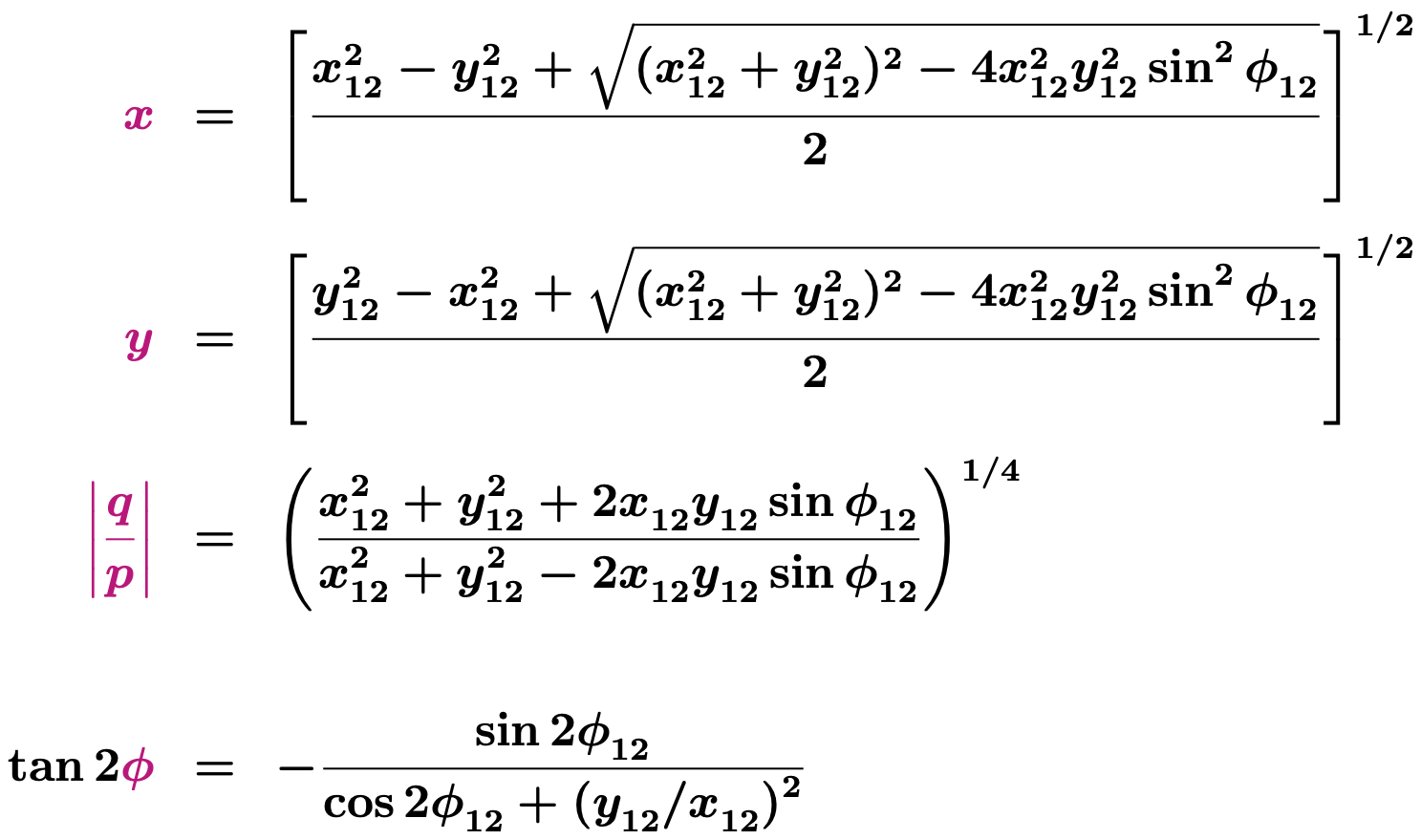
An alternative derivation of relations are given
here;
these give identical results as Kagan and Sokoloff.
Fit #3:
Two-parameter description of indirect CP violation
In this parameterization, sub-leading amplitudes in CF and DCS decays
are neglected as in Fit #2, and thus AD= 0.
However, to accommodate the "high-precision era" in charm mixing/CP violation
measurements, sub-leading amplitudes in SCS decays are taken into account
in indirect CP violation observables. There is one simplification:
D0→ K+K−, π+π−
final-state-dependent effects are neglected in AΓ, as they cancel at leading-order
in U-spin breaking.
The sub-leading SCS amplitudes contribute to Γ12 in addition to M12,
and thus Arg(Γ12) may be nonzero. To account for this, we fit for four parameters:
(x12, y12, φM2, φΓ2),
where φM2 and φΓ2 are the phases of
M12 and Γ12, respectively, relative to that of the dominant ΔU=2
dispersive and absorptive amplitudes.
This parameterization is discussed in
Kagan and Silvestrini. The relationships between (x, y, |q/p|, φ) and
(x12, y12, φM2, φΓ2) are:

The first three relations correspond to Eqs. (14), (15), and (48) of
Kagan and Sokoloff;
the last relation corresponds to Eq. (110) of
Kagan and Silvestrini.
Fit #4:
Two-parameter description of indirect CP violation (|q/p|, φ), direct CP violation in DCS decays allowed
In this case all parameters are floated, and we fit for the baseline parameters
(x, y, |q/p|, φ).
The MINUIT output for Fits #1 − #4 are given
here.
(Note that x, y, R D, A D, A π and A K are in
percent; δ, δ2 (=δKππ), and φ are in radians.)
The final results are:
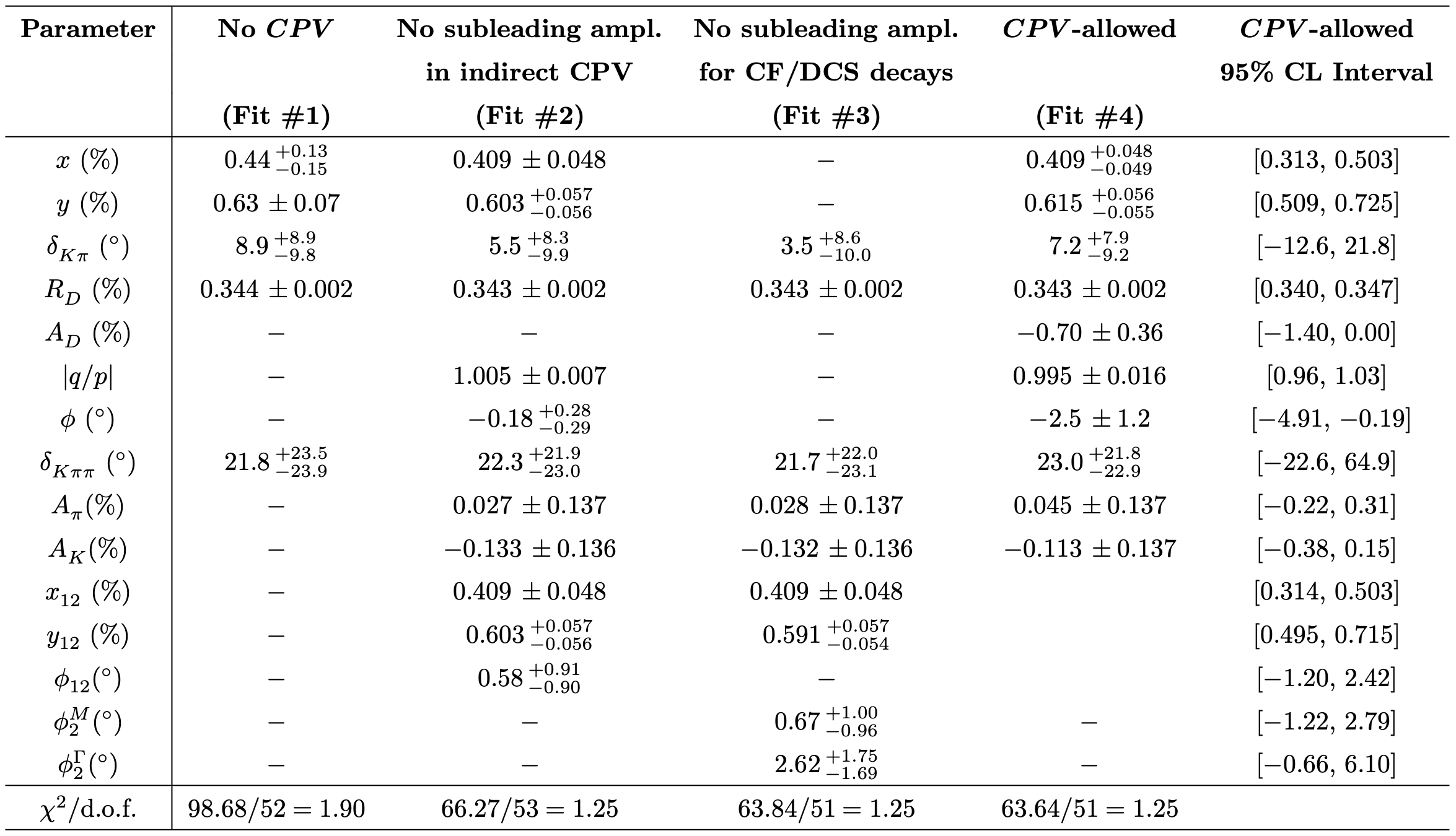
χ 2 contributions for the all-CPV-allowed fit #4:
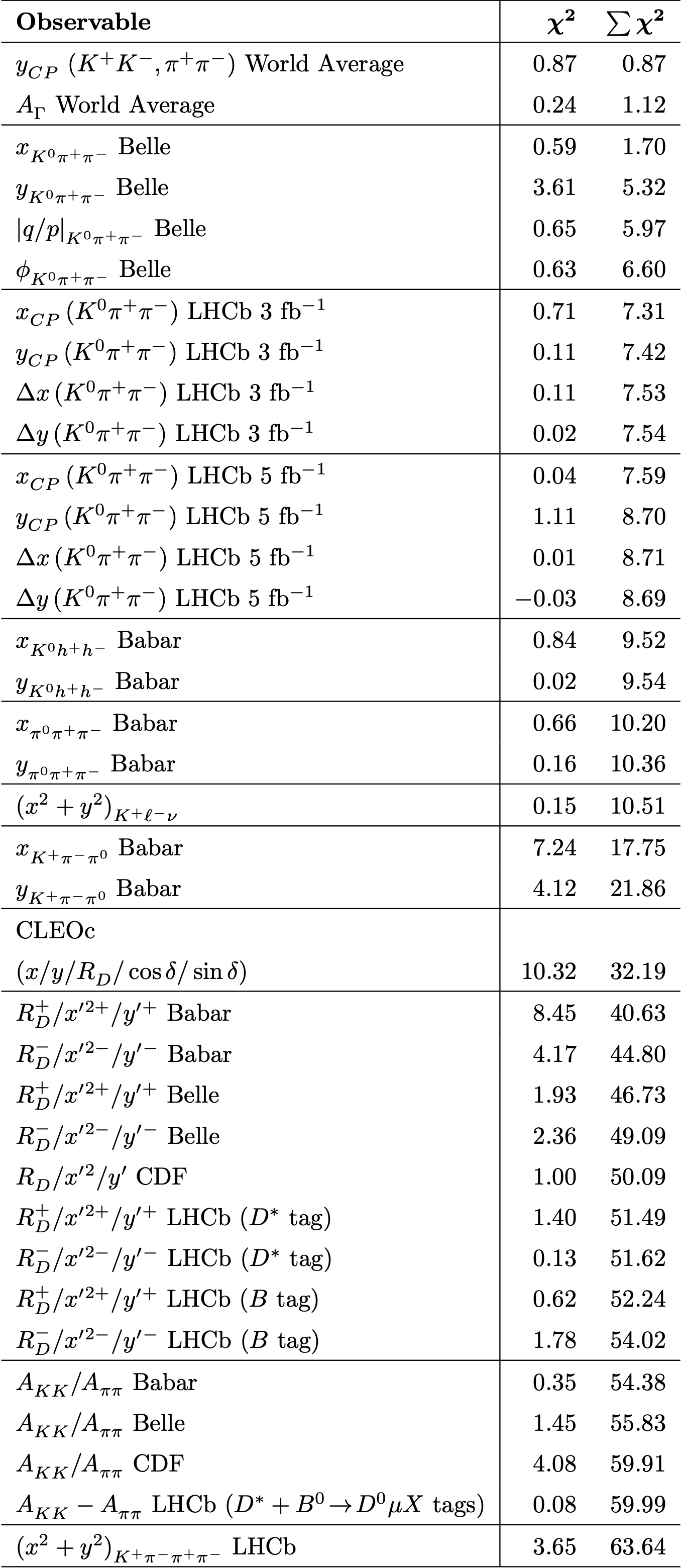 _____________________________________________
_____________________________________________
MNCONTOUR-like 2-d plots:
(click on for .eps versions)

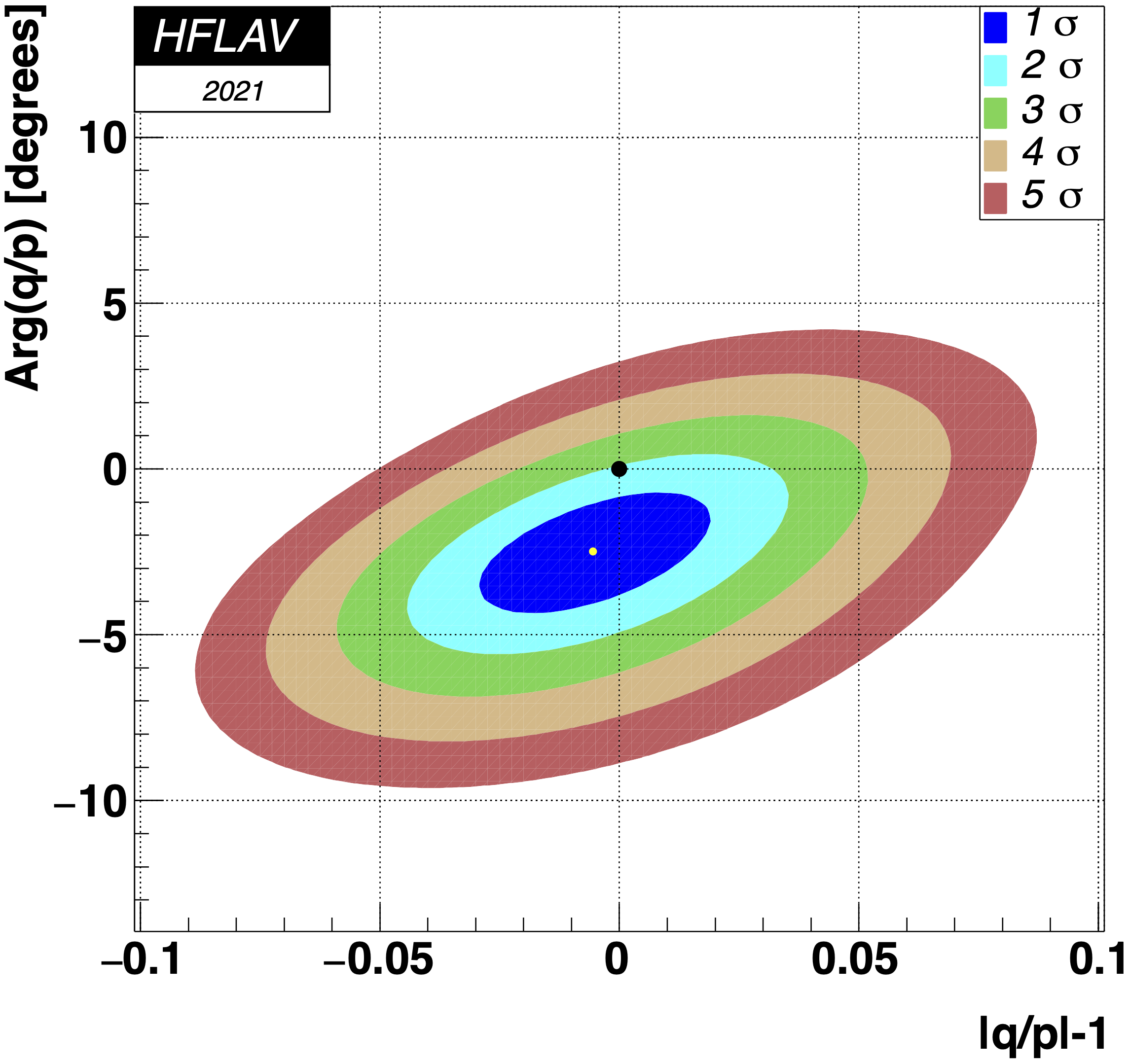
CPV-allowed plot, no mixing (x,y) = (0,0) point:
Δ χ 2 = 2099,
excluded at ≫ 11.5σ (limit of CERNLIB PROB routine)
No CPV (|q/p|, φ) = (1,0) point:
Δ χ 2 = 5.633,
excluded at 1.56σ
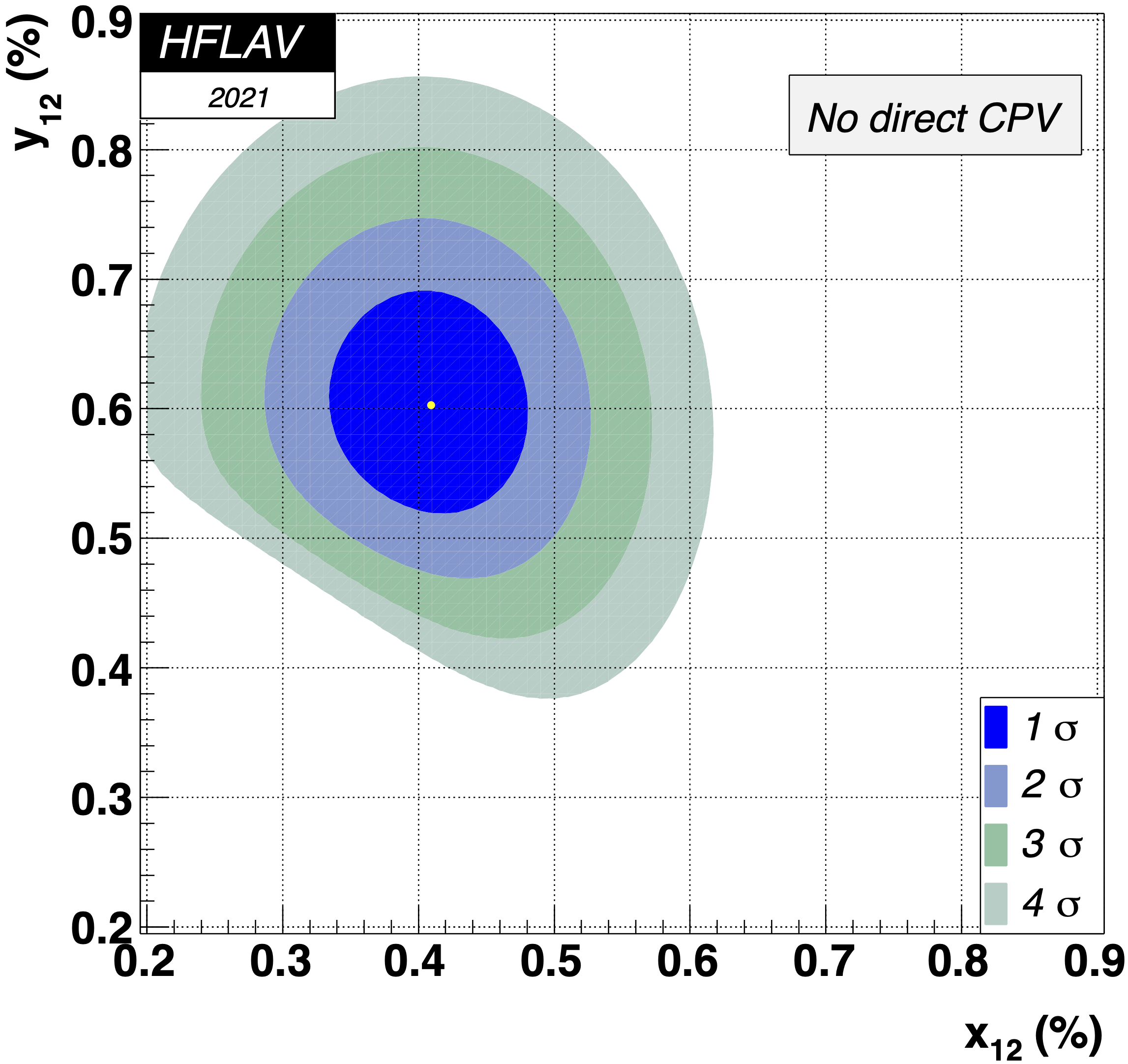
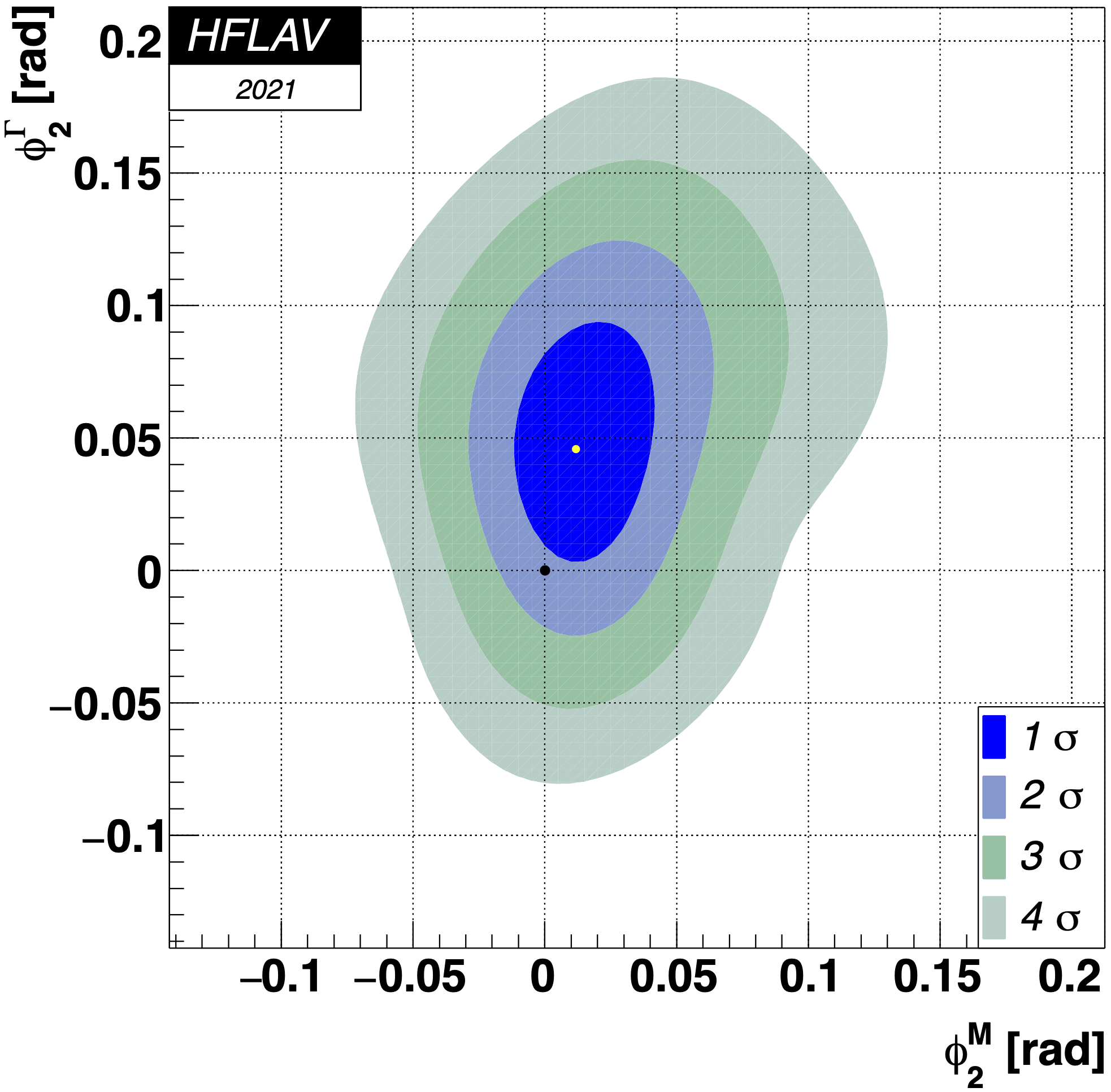
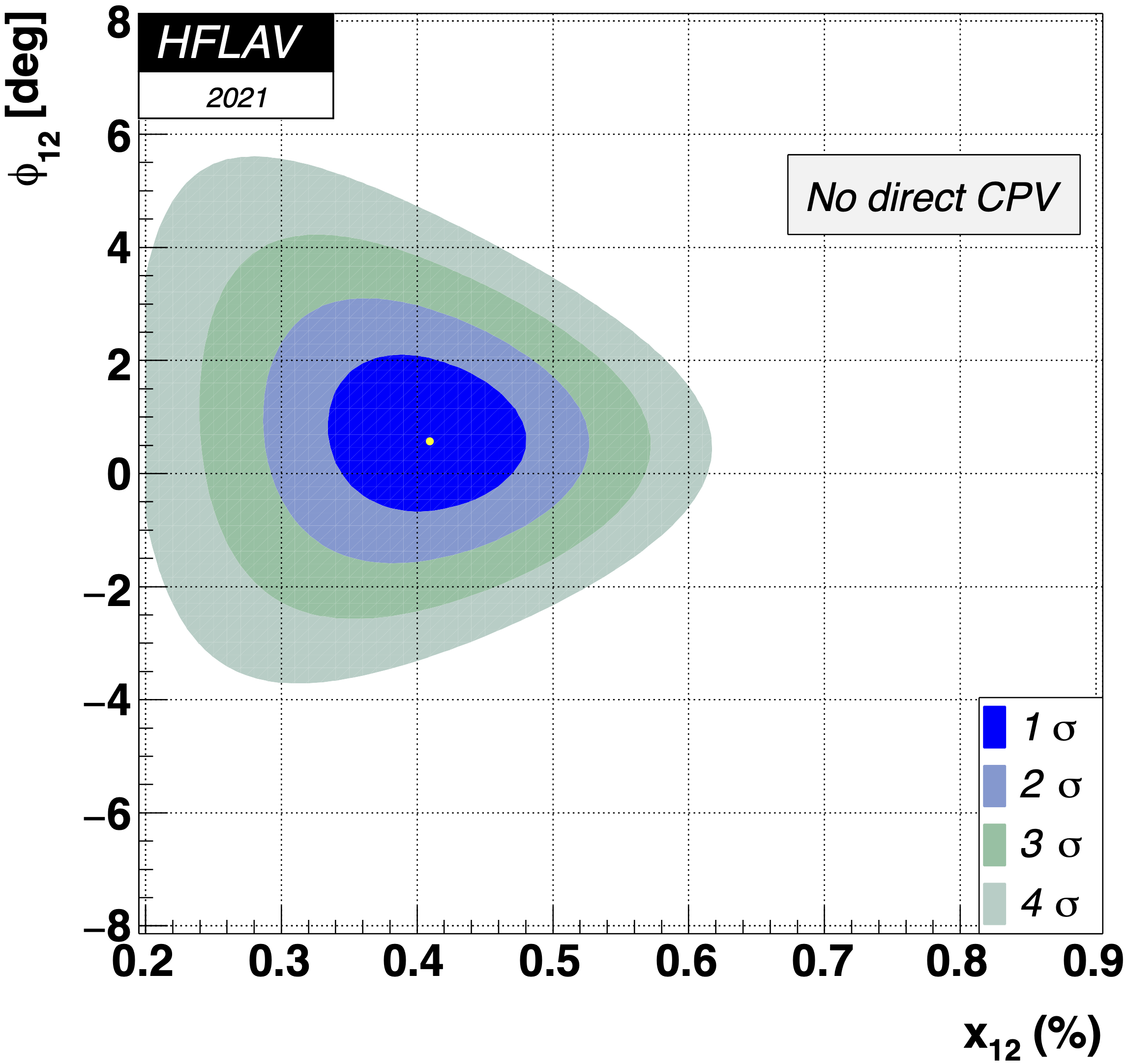
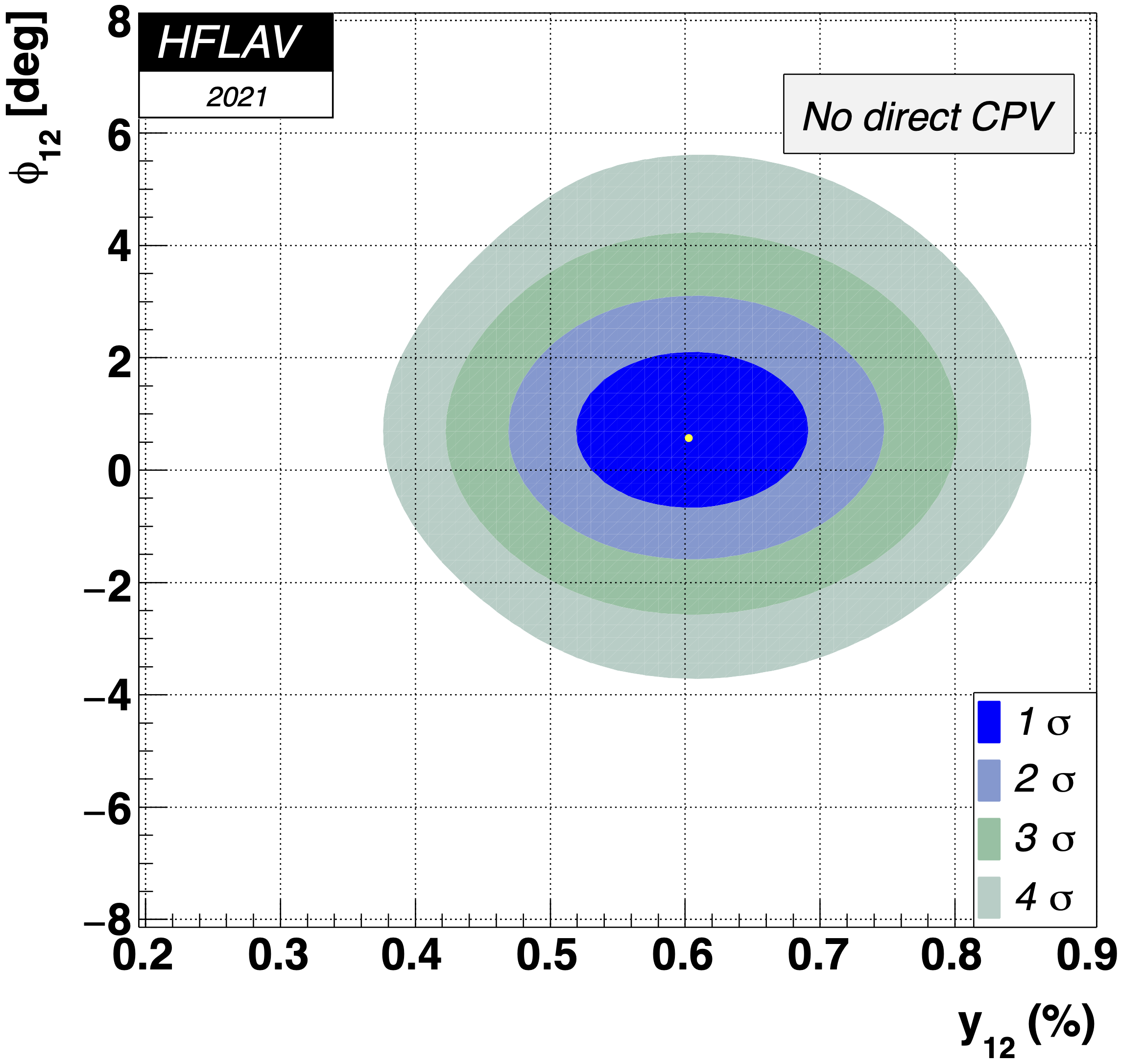
_____________________________________________
MNCONTOUR-like 1-d plots:
Dashed red
horizontal line denotes Δχ 2 = 3.84, corresponding to
a 95% C.L. interval.
(click on for .eps versions)
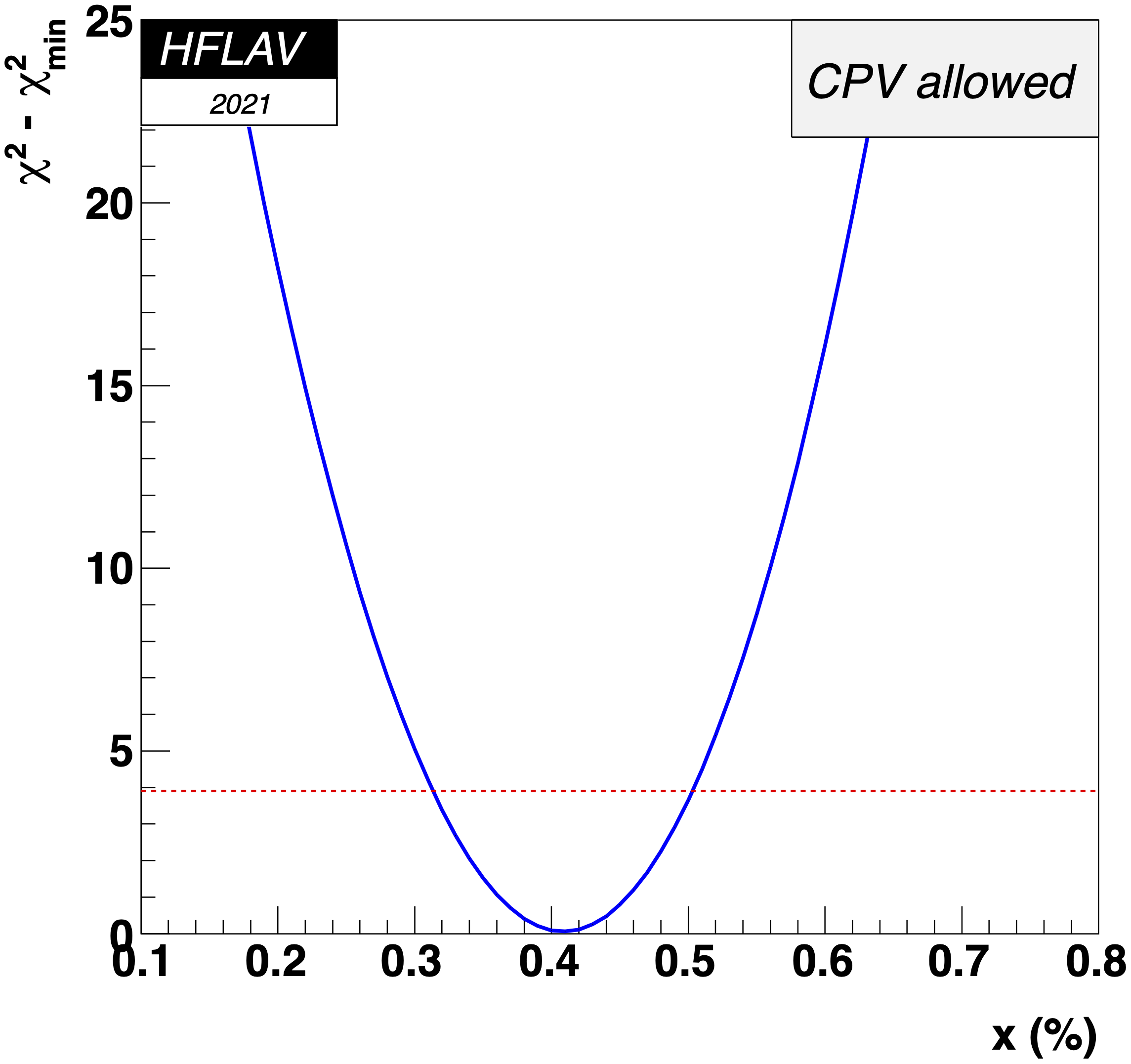

x = 0 point:
Δ χ 2 = 68.30,
x ≤ 0 excluded at 8.18σ
y = 0 point:
Δ χ 2 = 477.2,
y ≤ 0
excluded at > 11.4σ (limit of CERNLIB PROB)
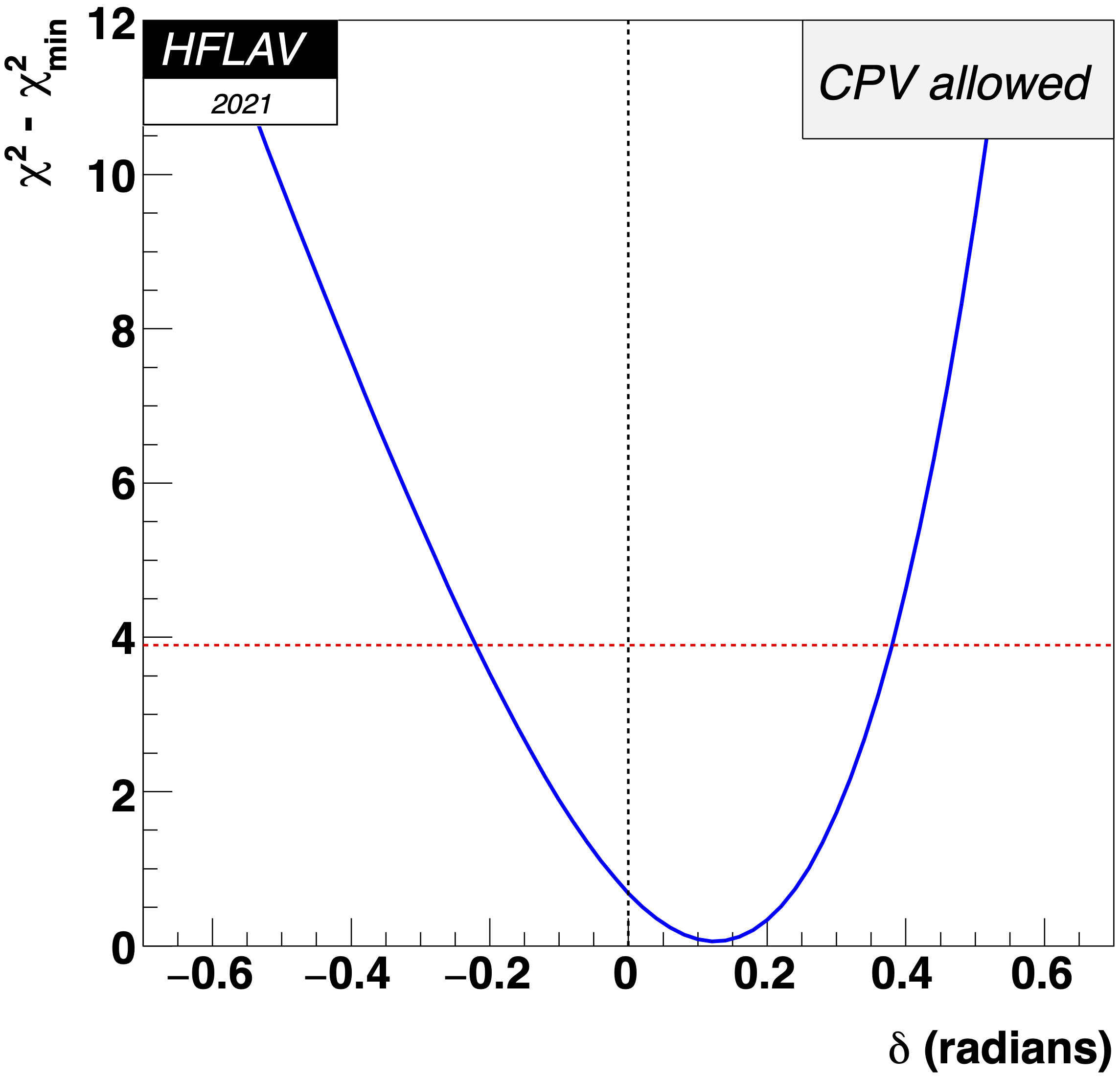
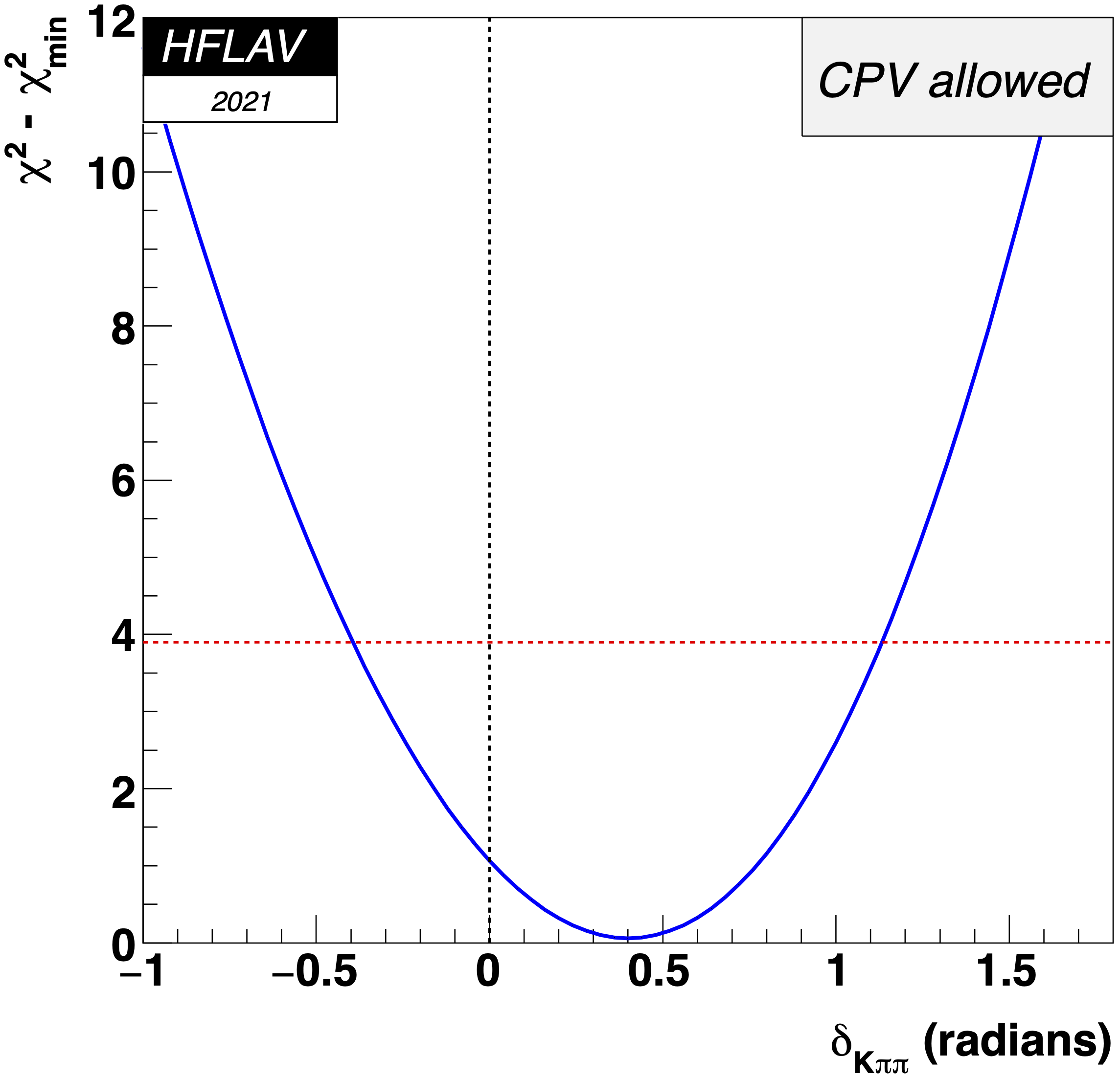
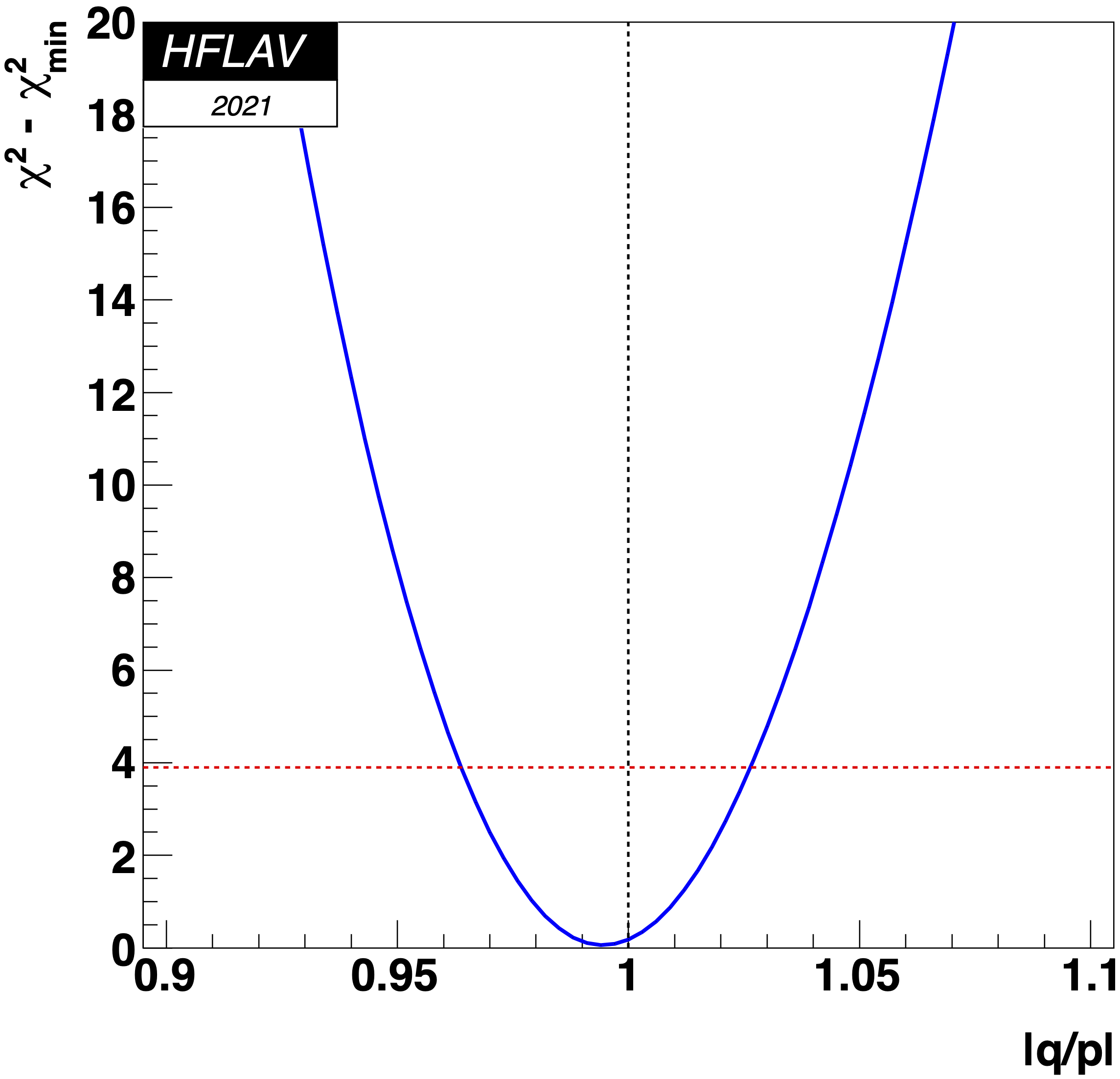
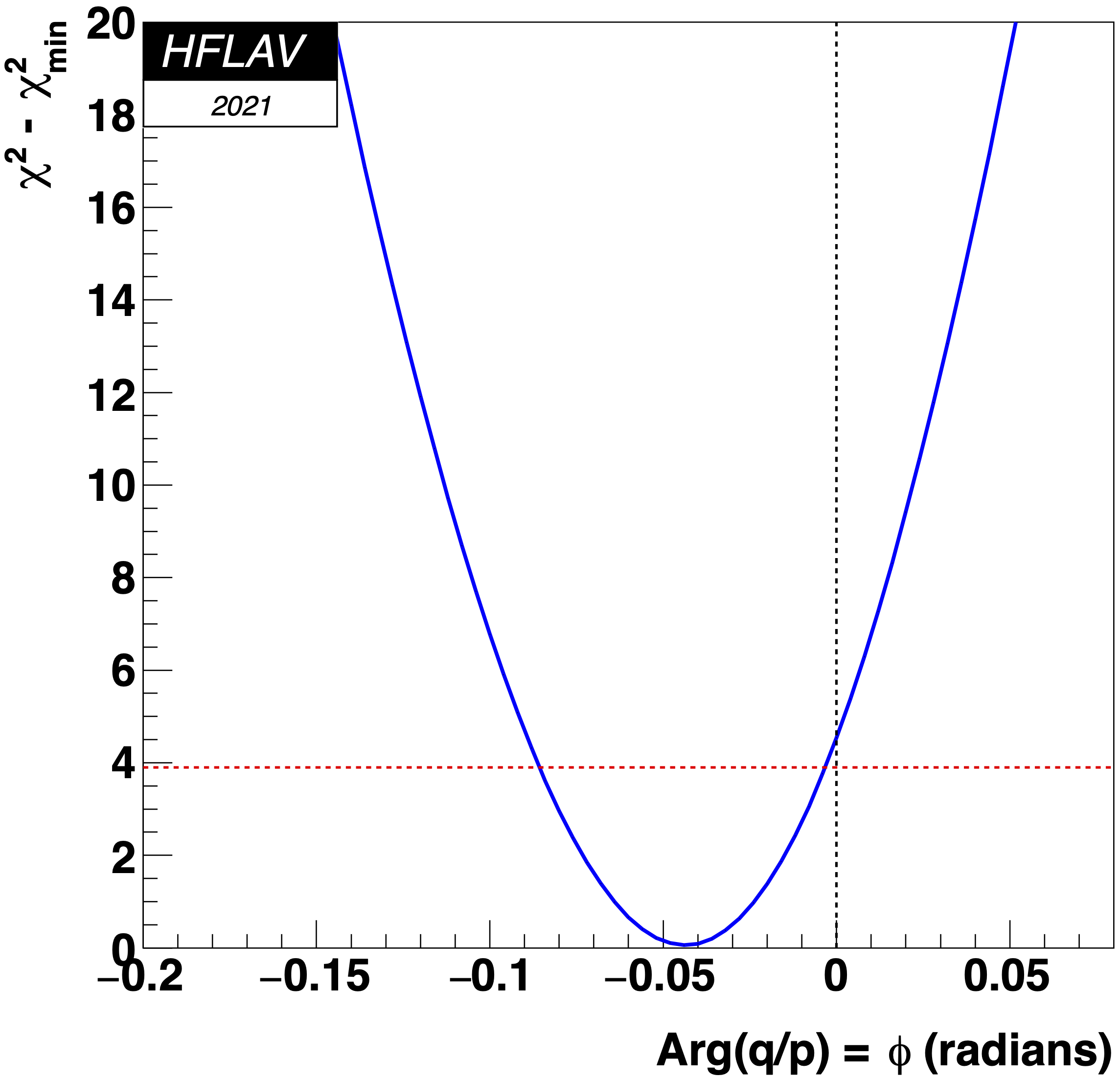
_____________________________________________
Comparison with results before LHCb's 5.4 fb−1
D0 →
K0S π+π −
measurement, using identical binning:
Left-most plots include all results
except for
LHCb's 5.4 fb−1 D0 →
K0S π+π −
measurement of (xCP, yCP, Δx, Δy);
right-most plots include that result too (all results).
(click on for .eps versions)
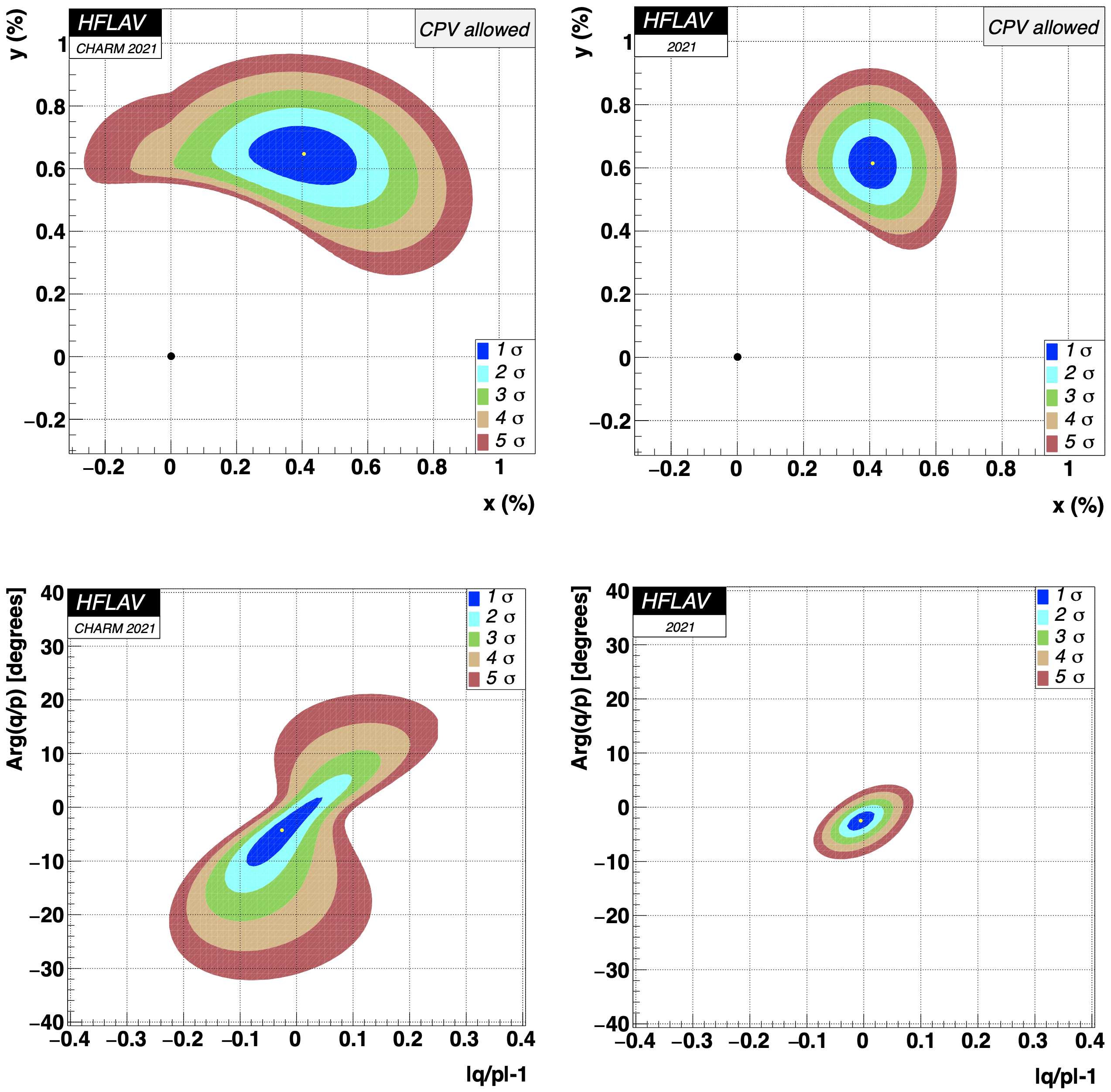
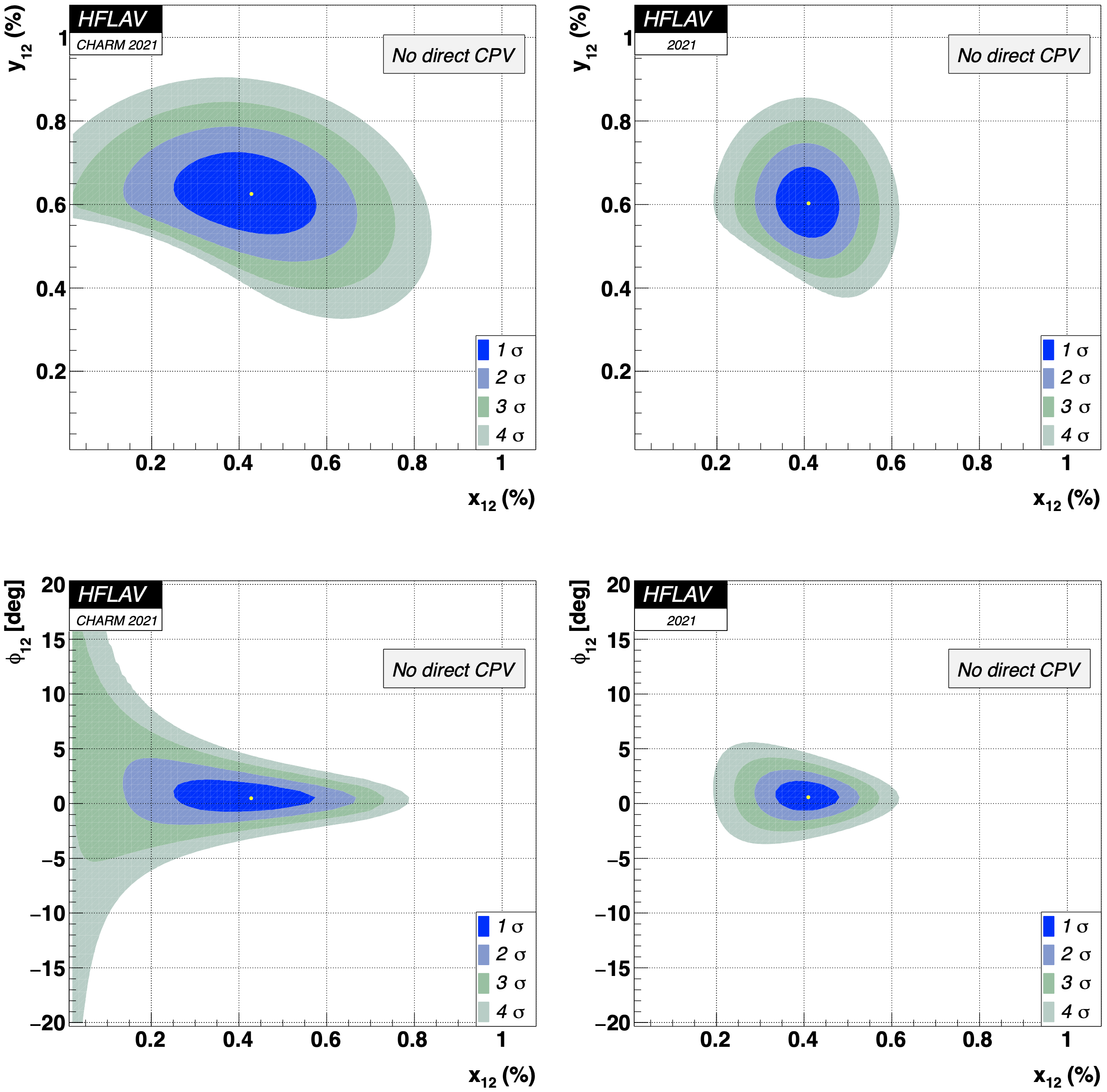
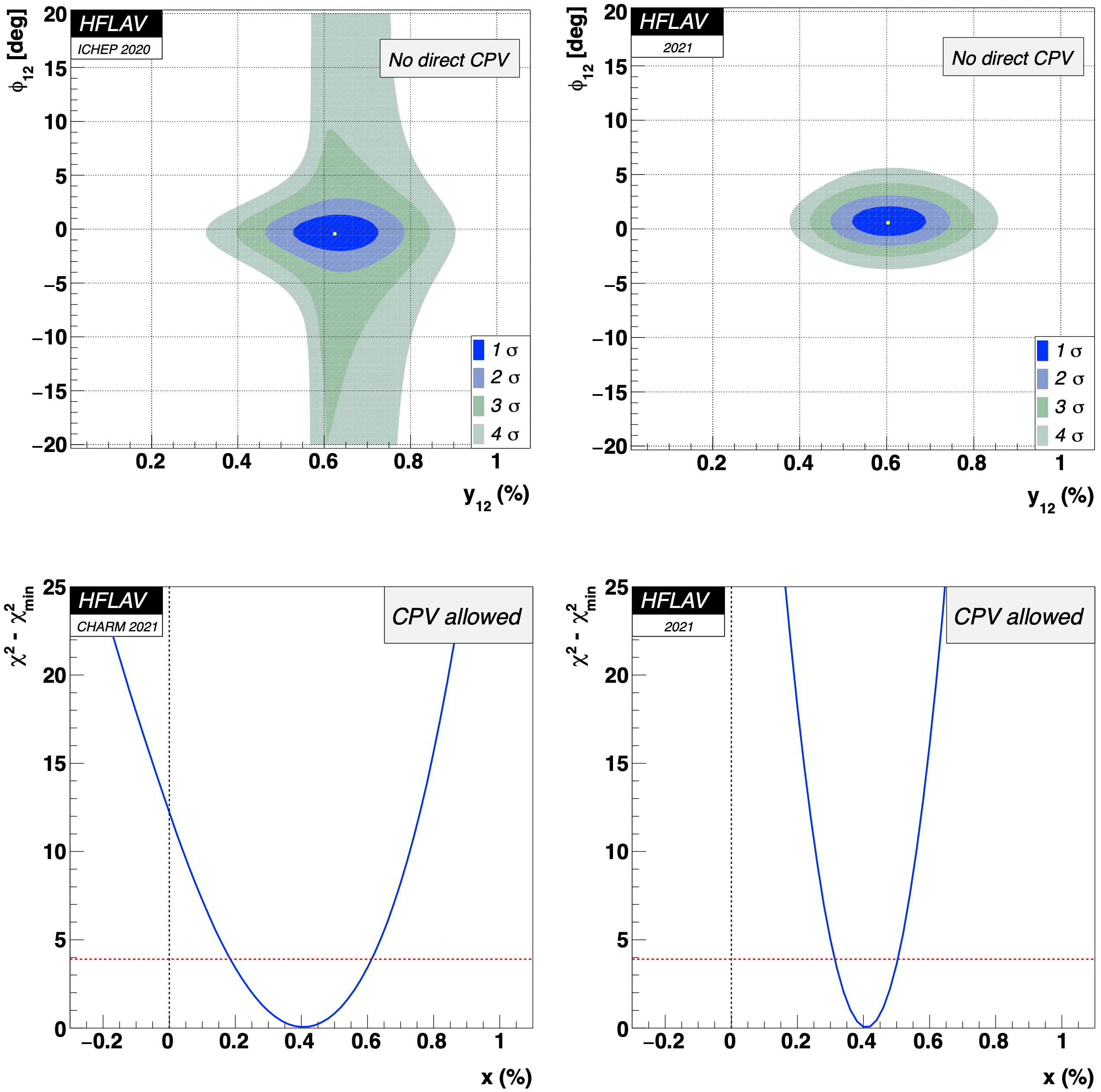

This page is maintained by
A. Schwartz
and was last updated











